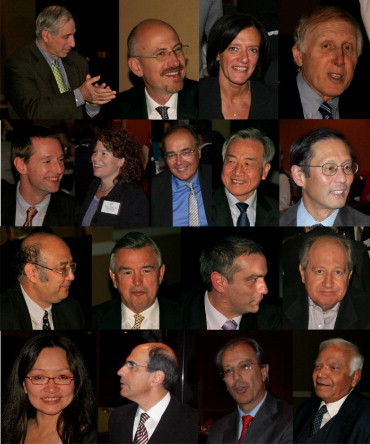In Minneapolis, Minnesota, on October 16 to 18, 2009, the fourth “International Summit on the Diagnosis and Management of Hypertrophic Cardiomyopathy and Prevention of Sudden Death: The Next 50 Years,” was held and sponsored by the Minneapolis Heart Institute Foundation in recognition of the fiftieth Anniversary of this disease ( Figure 1 ). During the previous half-century, hypertrophic cardiomyopathy (HC) persistently intrigued and challenged the cardiovascular community and, indeed, has periodically been the source of misunderstanding and even controversy. The 3 previous HC Summits held in Minneapolis were in 1997, 2002, and 2006 (with the meeting scheduled for September 14, 2001 canceled).

During the 2.5-day period, 215 attendees from 13 countries and 24 states heard 37 lectures from an international faculty of 25 speakers ( Figures 2 and 3 and Table 1 ). This unique program was dedicated to relating the expansive HC “story” from basic molecular genetics to clinical presentation and natural history, and, most importantly, to management options and decision-making—from the earliest studies in the 1960s to the present context of HC within contemporary cardiovascular medicine. The program integrated the older and well-recognized data with the more recent insights in an interactive symposium format, with adequate time reserved after each lecture for questions and discussion.


| Faculty/Guest Names | Location |
|---|---|
| Summit faculty ⁎ | |
| Barry J. Maron, MD (Director) | Minneapolis, MN |
| Christine E. Seidman, MD | Boston, MA |
| Heidi L. Rehm, PhD | Boston, MA |
| Martin S. Maron, MD | Boston, MA |
| Eugene Braunwald, MD | Boston, MA |
| E. Douglas Wigle, MD | Toronto, ON, Canada |
| Pravin M. Shah, MD | Newport, Beach, CA |
| Iacopo Olivotto, MD | Florence, Italy |
| Cristina Basso, MD | Padua, Italy |
| Franco Cecchi, MD | Florence, Italy |
| Paolo Spirito, MD | Genoa, Italy |
| Steven R. Ommen, MD | Rochester, MN |
| Michael J. Ackerman, MD, PhD | Rochester, MN |
| N. A. Mark Estes III, MD | Boston, MA |
| Robert G. Hauser, MD | Minneapolis, MN |
| Lisa Salberg | Rockaway, NJ |
| Christopher Semsarian, MD, PhD | Sydney, Australia |
| Rutai Hui, MD, PhD | Beijing, China |
| Antonio Pelliccia, MD | Rome, Italy |
| Domenico Corrado, MD, PhD | Padua, Italy |
| Mark V. Sherrid, MD | New York, NY |
| Joseph A. Dearani, MD | Rochester, MN |
| Anna Woo, MD | Toronto, ON, Canada |
| Rick Nishimura, MD | Rochester, MN |
| Harry Lever, MD | Cleveland, OH |
| Notable guests | |
| Joseph Murgo, MD | San Antonio, TX |
| David Richmond, MD | Sydney, Australia |
| Gunnar Gunnarsson, MD | Reykjavík, Iceland |
| Euan Ashley, MD | Palo Alto, CA |
| Charlene Day, MD | Ann Arbor, MI |
| Zinan Zhang, MD | Nanjing, China |
Special appreciation is extended to Dr. Eugene Braunwald for his first-time participation, which strengthened the program considerably. Among Dr. Braunwald’s many seminal contributions to cardiovascular medicine is the initial systematic description of HC with his colleagues at the National Institutes of Health 50 years ago ( Figure 4 ).

Recalling this successful and important conference affords the opportunity to revisit many of the important principles and ideas relevant to HC, as presented by the assembled faculty.
Basic Principles
- ●
HC is probably unrecognized clinically in most affected persons, with only the “tip of the iceberg” diagnosed.
- ●
It is the most common genetic cardiovascular disease, with a prevalence of 1:500 in the general population, and about 600,000 affected individuals in the United States.
- ●
HC is the most common cause of sudden death (SD) in the young, including trained athletes.
- ●
HC is an important cause of cardiovascular disability, including heart failure and atrial fibrillation (AF)/stroke.
- ●
Paradoxically, HC is often of little or no clinical significance and is frequently compatible with a normal life expectancy and longevity.
- ●
The clinical, morphologic, and genetic expression is highly heterogeneous.
- ●
It has a phenotypic expression, with asymmetric left ventricular (LV) hypertrophy that assumes diverse patterns, frequently including mild segmental hypertrophy (with normal LV mass).
- ●
Other phenotypic features include disorganized cellular architecture, expanded interstitial matrix, replacement fibrosis, microvascular remodeling, enlarged/elongated mitral valve leaflets, and congenital anomalies of the mitral apparatus.
Genetics
- ●
HC has extreme genetic heterogeneity, with 11 disease-causing genes and now >1,000 individual mutations, accounting for only 50% of patients with genetic testing.
- ●
80% of patients with positive genetic test results have MYBPC3 or MYH7 mutations.
- ●
In China, the distribution of HC genes differs, with fewer MYBPC3 and MYH7 mutations and the apparent absence of some previously identified “malignant” mutations (i.e., Arg 403 Gln).
- ●
A large proportion of HC mutations (about 2/3) are novel (“private”), occurring in only 1 family.
- ●
Commercial genetic testing is now widely available; however, “variants of unknown significance” not uncommonly pose clinical dilemmas for interpretation.
- ●
Family co-segregation studies represent the most productive strategy for resolving ambiguous mutations.
- ●
Murine models offer potential clues to disease mechanisms, novel treatment strategies, and possible prevention of disease phenotypes.
- ●
Sarcomeric mutations in the community might be associated with reduced penetrance and a lower risk of overt heart disease.
- ●
Some HC-causing mutations (e.g., MyBPC3) might be more common variants responsible for cardiomyopathies in some parts of the world (e.g., Southeast Asia).
- ●
Genetic testing of little value in predicting a patient’s future prognosis but can provide a definitive HC diagnosis in at-risk family members or, selectively, when the clinical findings are ambiguous.
- ●
HC phenocopies, with nonsarcomeric genetic substrates, can mimic true HC (e.g., Fabry’s disease, lysosome-associated membrane protein-2 [LAMP2], protein kinase adenosine monophosphate-activated gamma regulatory-2 subunit [PRKAG2], Noonan syndrome.
- ●
LAMP2 cardiomyopathy is a lysosome storage disease and HC phenocopy; it is associated with massive LV hypertrophy and death before 25 years of age; and it is refractory to implantable cardioverter-defibrillator (ICD) therapy.
- ●
Family screening using echocardiography/cardiovascular magnetic resonance imaging and electrocardiography is recommended, usually beginning at 12 years of age and every 12 to 18 months thereafter through adolescence.
- ●
A 2-month-old child, mutation-free by virtue of a preimplantation genetic diagnosis was presented to the conference by a HC patient (who is also the father).
Stay updated, free articles. Join our Telegram channel

Full access? Get Clinical Tree


